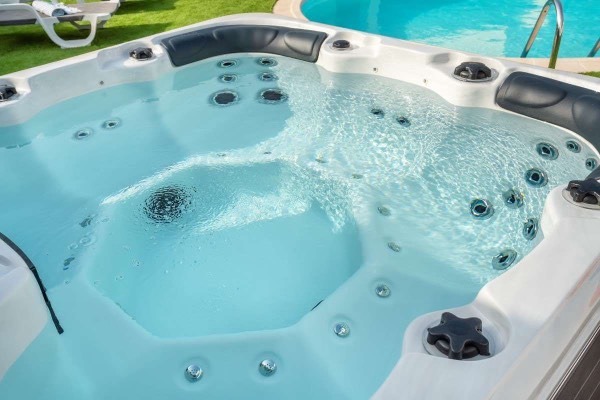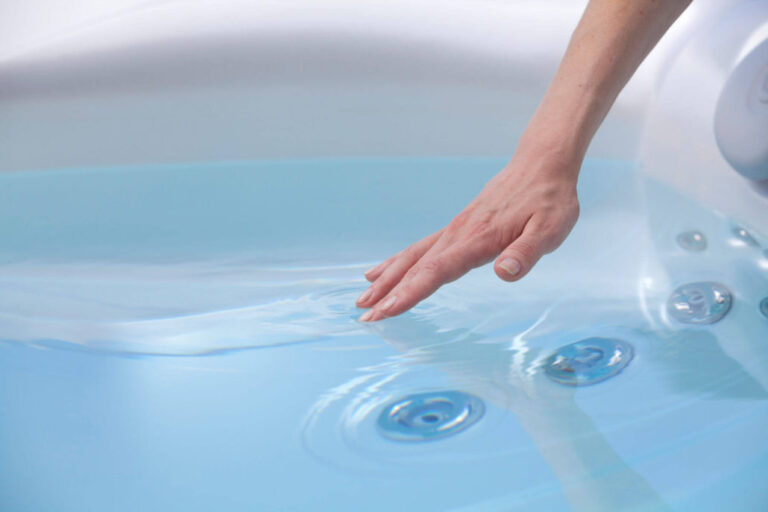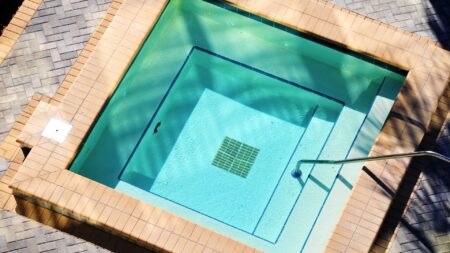The experience of soaking in a relaxing spa is something we all crave. The warm water, soothing bubbles and tranquil atmosphere are elements that transport us to a state of calm and well-being. However, to fully enjoy the benefits of your spa and ensure its longevity, it is essential to know how to properly treat the water and protect it with one of our spa covers.
As mentioned above, water treatment in your hot tub or spa is essential to maintain a healthy and relaxing environment. In this article, we will guide you through the key steps to effective hot tub water treatment. You will learn about water treatment equipment and how to keep your hot tub water crystal clear, as well as the control needed to enjoy your spa to its fullest.
Why is spa water treatment important?
Spa water treatment is essential to ensure a safe and enjoyable spa experience. If water treatment is not carried out properly, it can lead to illness or infection of the skin, eyes or respiratory system. In addition, poor spa water quality can reduce the effectiveness of water treatment chemicals and cause damage to the spa.
The quality of spa water treatment has a direct impact on the health and safety of spa users. If water is not subjected to proper water treatment, it can become a breeding ground for bacteria, viruses and unwanted micro-organisms. Contact with contaminated water can lead to skin diseases, eye irritation, respiratory infections and other health problems. Proper spa water treatment eliminates these threats and ensures that your spa experience is safe and enjoyable.
To keep spa water in optimal condition, it is necessary to use water treatment chemicals such as chlorine, bromine or ozone. If the water is not balanced and clean, these chemicals can become less effective. This not only puts the health of the users at risk, but can also result in unnecessary expenditure on chemicals that do not work properly. Proper spa water treatment ensures that water treatment chemicals work efficiently, which saves money in the long run.
Different ways to treat spa water
There are several effective methods to treat spa water and ensure its quality. Here are some of the most common methods:
Chlorine and bromine: Chlorine and bromine are the most common chemicals used to treat spa water. These chemicals kill bacteria and other microorganisms, and can be easily adjusted to maintain proper levels.
Ozone: Ozone is an odourless, tasteless gas that is used to sanitise spa water. Ozone kills bacteria and other microorganisms and breaks down quickly into oxygen, leaving no chemical residue in the water.
UV-C: UV-C light is another effective method of sanitising spa water. UV-C light kills bacteria and other microorganisms by breaking down their DNA. This method leaves no chemical residue in the water.
Salt systems: Salt systems convert salt into chlorine through a process of electrolysis. This allows proper chlorine levels to be maintained in the spa water without the addition of chemicals.
Copper-silver ionisation systems: Copper-silver ionisation systems release copper and silver ions into the spa water to kill bacteria and other micro-organisms. This method does not require the addition of chemicals and is more environmentally friendly.
What causes poor spa water quality?
Poor spa water quality can have two main causes that we should pay special attention to: the presence of bacteria and other micro-organisms, as well as water contamination.
Bacteria and other micro-organisms: The aquatic environment of a spa is ideal for the growth and proliferation of bacteria and other micro-organisms. If proper water treatment is not carried out, these tiny agents can trigger a number of problems. In the absence of proper water treatment, these micro-organisms can cause skin infections, eye irritation or affect the respiratory system of spa guests.
Water contaminants: Another factor that can contribute significantly to poor spa water quality is the presence of various pollutants. These water contaminants can take many forms, including chemicals, suspended particles and other undesirable elements that find their way into the spa water. The consequence of this water contamination can manifest itself in a variety of ways, from turbidity of the water to an unpleasant odour or strange taste.
How to Keep Hot Tub Water Crystal Clear
Learning how to keep your hot tub water crystal clear is essential to ensure an unparalleled relaxation experience in your personal spa. The transparency of water is not only a visual indicator of its quality, but also a reflection of its purity and safety for users. Here we provide you with a detailed approach on how to achieve and maintain that clarity in your hot tub water.
The process begins with the proper management of the pH and alkalinity levels of the water. Ensuring that these levels are in balance is critical to prevent the water from becoming acidic or alkaline, which could have a negative impact on bather comfort and the durability of hot tub components. Regularly check and adjust these values as needed to keep the water in an optimal state.
In addition, to keep the hot tub water crystal clear, it is imperative to maintain adequate levels of sanitizer, either chlorine or bromine. These chemicals play an essential role in eliminating microorganisms and bacteria that could proliferate in warm hot tub water. Use a chlorine or bromine meter to monitor and adjust sanitizer levels according to the size of your spa. By maintaining proper levels, you ensure clean, safe water for you and your guests.
Water Treatment Equipment
To achieve a flawless hot tub, it is essential to thoroughly understand the water treatment equipment that plays a crucial role in your spa’s water quality. In this section, we will explore the importance of this water treatment equipment and how it can make a difference in your relaxing experience.
Filtration and sanitizing systems are the cornerstones of effective water treatment in your hot tub. A high-quality hot tub filter is your first line of defense against impurities, particles and sediment that could contaminate your water. Be sure to select a filter that suits your spa’s specific needs and keep it clean and in good working order.
When it comes to sanitizing, there are several options for water treatment equipment, such as chlorine and ozone, which are essential for eliminating harmful bacteria, viruses and microorganisms. Each system has its advantages and disadvantages, so it is important to choose the one that best suits your personal preferences and needs. Regular maintenance and monitoring of sanitizer levels are essential to ensure that your spa is protected from contaminants and is a safe place to soak.
You should not underestimate the importance of regularly checking and maintaining this water treatment equipment. A clogged filter or inefficient disinfection system can compromise water quality and put users’ health at risk. Investing in high-quality water treatment equipment and performing proper maintenance are essential steps to enjoying a flawless, worry-free hot tub.
The importance of water control
Water control is an essential part of the water treatment process in your hot tub. Proper water control ensures that your spa maintains optimum levels of pH, alkalinity, chlorine or bromine and calcium. These parameters are critical to maintaining balanced and safe water for bathers.
To achieve this water control, it is advisable to use a water test kit that allows you to monitor and adjust these levels as needed. These kits are valuable tools for maintaining tight control over your spa’s water quality. Be sure to follow the kit’s instructions and keep track of the results to make appropriate adjustments.
In addition to regular monitoring and water control, you should not overlook the importance of periodically draining and filling your spa. This prevents the buildup of dissolved minerals and solids that can negatively affect water quality. The drain and fill cycle is essential to maintaining fresh, problem-free water over time.
How to adjust pH and alkalinity levels?
In addition to water treatment methods, it is important to adjust the pH and alkalinity levels of the spa water to keep them at the proper levels. The pH level of the water should be between 7.2 and 7.8, and the alkalinity level should be between 80 and 120 ppm. If the levels are out of balance, it can cause eye and skin irritation and reduce the effectiveness of treatment chemicals.
How often should hot tub or spa water be treated?
How often to treat hot tub or spa water is an important question for maintaining a healthy and relaxing environment. However, there is no single answer, as several factors influence the need for treatment. Here are some general guidelines for determining the proper frequency with which to treat spa water:
Spa Size: The size of your spa has a significant impact on the necessary frequency of water treatment. Larger spas contain a greater amount of water, which means that contaminants and chemicals are diluted at a higher rate. Generally, larger spas require more frequent treatments than smaller spas.
Frequency of Use: The number of times you use your spa also plays an important role. The more often you use it, the greater the load of contaminants that will be introduced into the water. If you use your spa regularly, you may need to treat the water more frequently.
Supply Water Quality: The quality of the supply water in your area may vary. If the water supply is of poor quality and contains minerals or impurities at elevated levels, you may need to treat the water more frequently to avoid buildup problems.
In general, it is recommended to treat spa water at least every two weeks as a starting point. However, it is crucial to regularly monitor water quality using test kits and adjust water treatment as needed. If you notice an increase in turbidity, changes in the odor or taste of the water, or if you experience chemical balance problems, such as fluctuations in pH or sanitizer levels, it is important to act immediately.
Remember that these are general guidelines and that the frequency of water treatment may vary depending on your specific circumstances. Regular maintenance and meticulous attention to water quality are essential to ensure that your hot tub or spa is a safe, healthy and relaxing place to be at all times.





